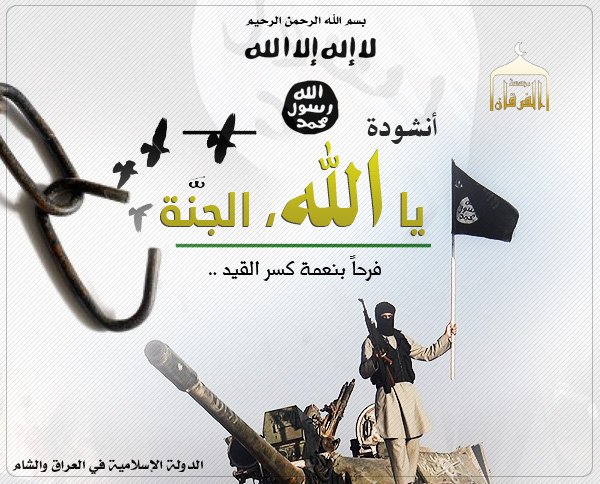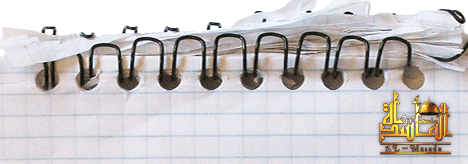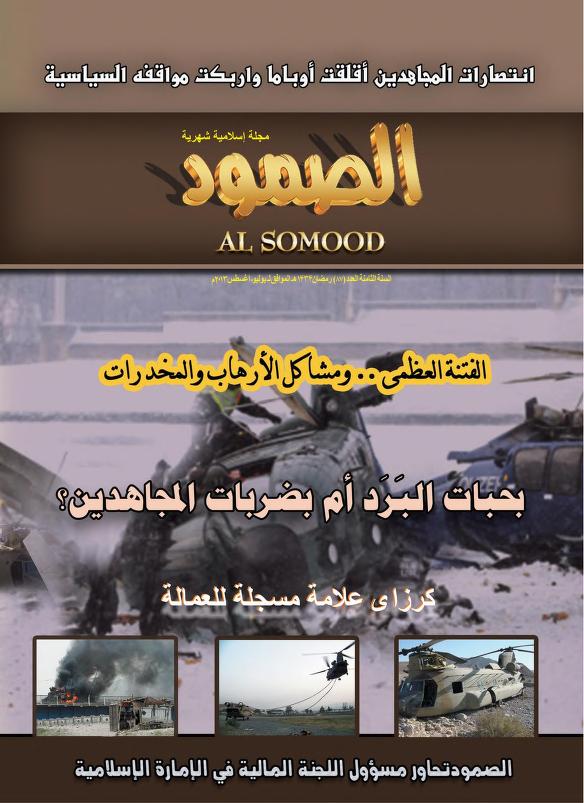
Islamic State of Iraq and al-Shām — “Oh God, Paradise”
____________
To inquire about a translation for this nashīd for a fee email: [email protected]
Month: July 2013
al-Ma’sadat Media Foundation presents a new article: “Biographies of the Martyrs in Bilād ash-Shām #6: Abū Hājr al-Tūnisī (Ḥamzah al 'Aūnī)”

Click the following link for a safe PDF copy: al-Ma’sadat Media Foundation — “Biographies of the Martyrs in Bilād ash-Shām #6- Abū Hājr al-Tūnisī (Ḥamzah al ‘Aūnī)”
_________
To inquire about a translation for this article for a fee email: [email protected]
al-Manārah al-Bayḍā’ Foundation for Media Production presents a new video message from Jabhat al-Nuṣrah: “Beginning of the End #14"
Masāma' al-Khayr l-l-Inshād presents a new audio poem from al-Batār al-Shāmī: "Your Blood"

al-Batār al-Shāmī — “Your Blood”
_________
To inquire about a translation for this nashīd for a fee email: [email protected]
New article from Dr. Akram Ḥijāzī: "The Digital Conflict Between the Center and the Margin"

Click the following link for a safe PDF copy: Dr. Akram Ḥijāzī — “The Digital Conflict Between the Center and the Margin”
_________
To inquire about a translation for this article for a fee email: [email protected]
English translation of book from Shaykh Abū Basīr al-Ṭarṭūsī: "Rulings and Issues Related to Ramaḍān"

Click the following link for a safe PDF copy: Shaykh Abū Basīr al-Ṭarṭūsī — “Rulings and Issues Related to Ramaḍān” (En)
__________
Two new statements from Jabhat al-Nuṣrah

Click the following links for safe PDF copies:
Jabhat al-Nuṣrah — The Second Report on Some of the Operations Bombing Vehicles in Rural Aleppo (Ramaḍān 2013)
Jabhat al-Nuṣrah — Liberation of Khan al ‘Asal and Cleansing It From the Nuṣayrī Army Forces in Rural Aleppo
____________
To inquire about a translation for these statements for a fee email: [email protected]
The Islamic Emirate of Afghanistan releases Issue #87 of al-Ṣamūd Magazine
NOTE: Previous issues: #86, #85, #84, #83, #82, #81, #80, #79, #78, #77, #76, #75, #74, #73, #72, #71, #70, #69, #68, #67, #66, #65, #64, #63, #62, #61, #60, #59, #58, #57, #56, #53, and #51. You can also see English translations of articles from previous issues here.
—

Click the following link for a safe PDF copy: The Islamic Emirate of Afghanistan — Issue #87 of al-Ṣamūd Magazine
_________
To inquire about a translation for this magazine issue for a fee email: [email protected]
New statement from Jabhat al-Nuṣrah: "The Battle of Liberating the Village of Dayr Sulaymān in Eastern al-Ghūtah in Rural Damascus"

Click the following link for a safe PDF copy: Jabhat al-Nuṣrah — “The Battle of Liberating the Village of Dayr Sulaymān in Eastern al-Ghūtah in Rural Damascus”
____________
To inquire about a translation for this statement for a fee email: [email protected]
Check out my new article in The CTC Sentinel co-authored with Daveed Gartenstein-Ross and Andrew Lebovich: "al-Qa'ida in the Islamic Maghreb’s Tunisia Strategy"
 During the last two years, Salafist activity has escalated in Tunisia. Much of this activity—primarily da`wa (religious outreach) designed to expand the Salafist movement—has taken place under the auspices of Ansar al-Shari`a in Tunisia (AST), headed by veteran jihadist Saifullah bin Hassine (also known as Abu Iyadh al-Tunisi).[1] A series of security incidents in and around Tunisia, however, have been attributed to al-Qa`ida in the Islamic Maghreb (AQIM), and more recently to an opaque group known as the Uqba ibn Nafi Brigade.[2] Regional security officials have described the Uqba ibn Nafi Brigade as an attempt to establish a Tunisian jihadist group linked to AQIM, one that purportedly combines local recruits from western Tunisia’s Kasserine area and some members of AST under the guidance and leadership of figures reputedly close to AQIM leader Abdelmalek Droukdel (also known as Abu Mus`ab al-Wadud).[3] Regional security officials, therefore, perceive the incidents on Tunisia’s border with Algeria beginning in late April 2013 as highlighting AQIM’s increased focus on Tunisia.
This article analyzes how AQIM, viewing events in Tunisia through its strategic lens, has responded to that country’s revolution. It finds that AQIM has tried to insert itself into AST’s relationship with the Tunisian state. AQIM has urged AST to be patient to prevent the Tunisian government from cracking down on its activities. At the same time, AQIM’s rhetoric toward the Tunisian state has become sharper, opening the possibility of an increase in AQIM-related violence in Tunisia.
Click here to read the rest.
During the last two years, Salafist activity has escalated in Tunisia. Much of this activity—primarily da`wa (religious outreach) designed to expand the Salafist movement—has taken place under the auspices of Ansar al-Shari`a in Tunisia (AST), headed by veteran jihadist Saifullah bin Hassine (also known as Abu Iyadh al-Tunisi).[1] A series of security incidents in and around Tunisia, however, have been attributed to al-Qa`ida in the Islamic Maghreb (AQIM), and more recently to an opaque group known as the Uqba ibn Nafi Brigade.[2] Regional security officials have described the Uqba ibn Nafi Brigade as an attempt to establish a Tunisian jihadist group linked to AQIM, one that purportedly combines local recruits from western Tunisia’s Kasserine area and some members of AST under the guidance and leadership of figures reputedly close to AQIM leader Abdelmalek Droukdel (also known as Abu Mus`ab al-Wadud).[3] Regional security officials, therefore, perceive the incidents on Tunisia’s border with Algeria beginning in late April 2013 as highlighting AQIM’s increased focus on Tunisia.
This article analyzes how AQIM, viewing events in Tunisia through its strategic lens, has responded to that country’s revolution. It finds that AQIM has tried to insert itself into AST’s relationship with the Tunisian state. AQIM has urged AST to be patient to prevent the Tunisian government from cracking down on its activities. At the same time, AQIM’s rhetoric toward the Tunisian state has become sharper, opening the possibility of an increase in AQIM-related violence in Tunisia.
Click here to read the rest.

